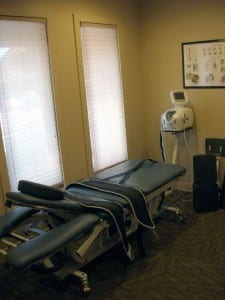Spinal Decompression
- Mar, 17, 2025
- Trenton Talbitzer
- Back Pain, Chiropractic
- No Comments.
Spinal Decompression
Is spinal decompression a good fit for you? Decompression is an effective treatment for spinal pain. Low back or neck pain can be caused by many different factors. A common mechanism is the compression of the disc or facet joints putting pressure on soft tissues, blood supply, and nerves. That compression results in pain, inflammation, and disability. These injuries start by a variety of mechanisms. Of course, trauma can cause a compression injury. Stepping in a hole or missing a step can jar the body compressing the spine. Another mechanism is repetitive actions/positions. Someone who stands all day on concrete may find that their spine is compressing over time. Repetitive trauma can also cause these injuries. Bouncing around in a tractor or on a 4-wheeler could be the source of these injuries.
compression of the disc or facet joints putting pressure on soft tissues, blood supply, and nerves. That compression results in pain, inflammation, and disability. These injuries start by a variety of mechanisms. Of course, trauma can cause a compression injury. Stepping in a hole or missing a step can jar the body compressing the spine. Another mechanism is repetitive actions/positions. Someone who stands all day on concrete may find that their spine is compressing over time. Repetitive trauma can also cause these injuries. Bouncing around in a tractor or on a 4-wheeler could be the source of these injuries.
Regardless of the mechanism of injure, typically compression starts with localized pain around the site of injury. As time goes on the pain starts spreading out from that localized spot. If the injury progresses, the pain may start going down an extremity. The next stage is numbness and/or tingling going down an extremity. Finally, if this injury is not reversed, weakness in the muscles of the extremity leading to symptoms like drop foot or grip weakness. Thankfully, decompression is an effective treatment for spinal pain no matter what stage an injury is at.
What happens During a Treatment?
During a decompression treatment, you lie on your back and are strapped onto a table. If it is a low back decompression, there are straps around your chest and waist. If it is a cervical decompression, your head sits in a cradle with a strap across the forehead. The decompression machine is hooked to either the strap or cradle and it starts the pulling process. The machine goes through a set procedure of distraction and relaxation to stretch the spine without engaging the muscles so your body does not fight the pull. This stretching slowly separates your spinal vertebrae to exact specifications to restore normal positioning. With every visit the strength of the pull is increased up to the maximum allowed by your weight.
What are the effects on your Spine?
Spinal decompression has the following effects on your spine: First, decompression increases the volume of the discs. Next, it lowers the pressure in the discs creating a vacuum. Third, it increases absorption of nutrition and fluids into the discs. Fourth, waste products are free to diffuse out of the disc creating more space for good nutrients. Finally, the vacuum mentioned previously reduces disc bulges and herniations. These effects happen every visit, but as soon as the treatment is done and you stand up gravity starts to have an effect on your spine bringing that compression back. It takes multiple visits over a period of time to help those effects become permanent.
These changes can be seen and tracked on an MRI. Numerous studies have shown that decompression tables increase the healing process of disc tears and reduce bulges and herniations. Rehydration of the disc is also something that can be seen on an MRI. Finally, patient feedback reveals across multiple studies that improvement is seen in pain and activities of daily living. These factors combine to make decompression an effective treatment for spinal pain.
- Allergy Relief (5)
- Autoimmune (3)
- Back Pain (7)
- Chiropractic (9)
- Food Info (3)
- Health Tips (9)
- Internal Medicine (13)
- MLS Laser (5)
- Nutrition (3)
- Office Information (2)
- Recipes (4)
- Testimonials (6)

Leave a Comment